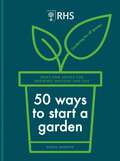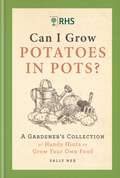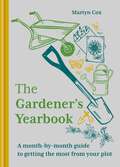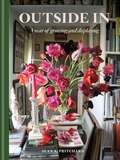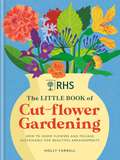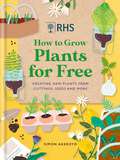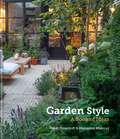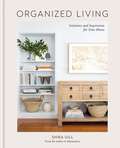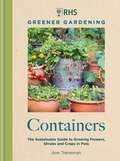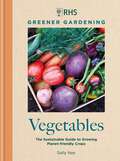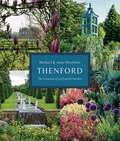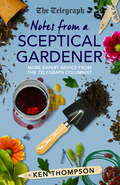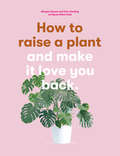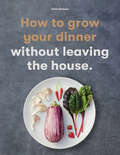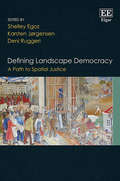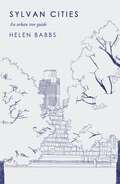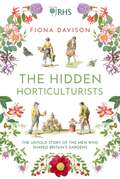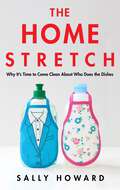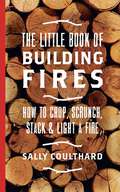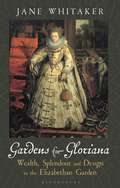- Table View
- List View
RHS 50 Ways to Start a Garden: Ideas and Inspiration for Growing Indoors and Out
by Simon Akeroyd***Aimed at first-time gardeners, those in rented accommodation or anyone with limited outdoor space, this book teaches how to take stock of an environment and start a garden. With ideas for gardens, patio spaces, courtyards, balconies and interiors, these 50 easy-to-adopt ideas provide the steps to success for even the most inexperienced gardeners. Contents include: - Create a floral display with bulbs that last all year - Grow pet-friendly plants- Create a vegetable harvest in pots - Add height in flat spaces- Make a mow-free lawn - Hang plants around your home
RHS Can I Grow Potatoes in Pots: A Gardener's Collection of Handy Hints for Incredible Edibles
by Sally Nex***This easy Q&A format book is suited to both beginner and more experienced growers, and encompasses a wide range of subjects to take readers beyond the basics of fruit and vegetable growing. Taking into account the popularity for growing food from scratch among newbie gardeners, you'll find advice in this book whether you have a garden, an allotment, or even a balcony or other small space to work with-everyone can get involved with growing delicious edibles no matter what space they have available. Discover: - Which varieties to choose for gourmet home cooking, the most nutritious crops to grow, and how to grow unusual edibles like olives. - Techniques and tips to get the most out of each crop, from how to grow epic-size pumpkins to whether it's worth thinning beetroot. - Troubleshooting tips for pest problems: ways to work with wildlife rather than against it and providing an alternative viewpoint on traditional problems, such as eating the weeds as well! - How to make the most of your fruit and vegetable harvest, with information on the best time to pick produce and how to preserve it.
The Gardener's Yearbook: A month-by-month guide to getting the most out of your plot
by Martyn Cox'An experienced horticulturist's monthly guide to gardening, with wise, clear and helpful advice on tackling the essential tasks and dealing with problems.' Gardens IllustratedOne of the keys to happy gardening is knowing what to do and when for the best results. In this handy guide, experienced horticulturist Martyn Cox takes you through the gardening year, month by month, offering wise, clear and helpful advice on the essential tasks and how to avoid problems along the way.No matter the size of the plot, nor the expertise of the gardener, The Gardener's Yearbook is the perfect handbook to return to throughout the seasons, with tips including:- How to get your lawn into shape for the summer- When you should plant lilies, roses and sweet peas- How and when to harvest and store your fruit and vegetables- When to prepare containers for winter- How to fit a water butt and start a compost bin- An easy-to-follow crop plannerFeaturing specially commissioned linocuts by artist Heather Tempest-Elliott.
Outside In: A Year of Growing & Displaying
by Sean A Pritchard'Inventive, considered, and thoughtful design.' House & GardenIn his debut book, garden designer Sean A Pritchard shows you how to plan a garden so that every month of the year there's something to bring indoors and display in an engaging way. From the cheery joy of early spring daffodils to the velvety richness of late-summer dahlias, the deep glow of golden autumn leaves to the optimism of late-winter catkins, Sean explains how to grow, harvest, and arrange an abundance of nature's treasure - no matter the size of your plot or your level of horticultural experience.
RHS The Little Book of Cut-Flower Gardening: How to grow flowers and foliage sustainably for beautiful arrangements
by Holly FarrellFlowers brighten our homes, our lives and, when they are homegrown, they also brighten our gardens - not just for us, but also for the buzzing wildlife that loves their nectar. Growing your own flowers gives the huge satisfaction of harvesting something from a plant you have nurtured, and brings a greater connection with nature and the seasons. It also allows you to have a house full of flowers at a fraction of the cost of buying them, all with a sustainable, positive environmental impact. RHS The Little Book of Cut-Flower Gardening is the perfect introduction to growing your own blooms. Whether your cut-flower patch is a handful of pots or half an allotment, you'll find accessible information on successful and sustainable growing, to keep your plot healthy and as productive as possible. As well as introductory chapters on planning and gardening basics, there are details on how to cut your flowers and extend their vase life,and how to dry flowers for everlasting arrangements.More than just flowers, the directories break down the blooms and foliage into their different groups. There are sections on annuals from seed, such as love-in-a-mist, ammi and sweet peas; growing bulbs and tubers such as tulips and dahlias; perennials for flower and foliage, such as lady's mantle, lavender, roses, apple mint and ornamental grasses; and shrubs and trees for foliage, flower, spring blossom and colourful winter stems.
RHS How to Grow Plants for Free: Creating New Plants from Cuttings, Seeds and More
by Simon AkeroydIncrease your stock of plants easily and for free by propagating them yourself. RHS How to Grow Plants for Free demystifies the art of taking cuttings and explains the other ways you can multiply your garden plants. Propagating your own plants is fun, inexpensive, and a sustainable way to garden.An introductory section explains the botanical science behind all types of propagation and defines and simplifies the language. The book is then split into self-contained practical chapters detailing each of the different types of propagation. Each chapter includes a selection of 'plant profiles' for the plants best suited to eachpropagation method: - Dividing Plants covers the easiest methods of splitting one plant into several new ones- Saving Seeds introduces how to collect and process seeds from flowers, vegetables, herbs and trees- Cuttings covers how to successfully grow a new plant from an existing one using several different methods for taking cuttings- The Houseplants chapter shows techniques needed to increase your collection.- The final chapters show how to grow new plants from kitchen scraps, and gives ideas on how to make the most of all the new plants you've created by giving them as gifts
Garden Style: A Book of Ideas
by Heidi Howcroft Marianne MajerusGardens have never been as important as they are today. The breadth of styles and types is hugely varied. Everything goes, whether inspired by the past or looking towards the future, from traditional vegetable plots to vertical gardens and from nature-filled designs to sleek, modernist creations. Choosing what suits your space can be a daunting prospect and everyone, even the professionals, needs help to realize opportunities and create outdoor spaces in tune with their personal needs and dreams. A garden is what we make it: there is no right or wrong way and each is unique.Richly illustrated by the photos of award-winning photographer Marianne Majerus and with illuminating text by landscape architect Heidi Howcroft, this book shows what is possible for every type of garden, from challenging small spaces to expansive plots. Design tools are explained, planting styles explored, and inspiration is drawn from a wide variety of locations and climates to appeal to garden owners and designers everywhere.The book is not only a companion to Garden Design: A Book of Ideas but is also a valuable style catalogue and sourcebook in its own right, encouraging and inspiring readers to discover their own garden style - be it contemporary or traditional, cottage-style or urban minimalist.
The Home Edit Stay Organized: The Ultimate Guide to Making Systems Stick
by Clea Shearer Joanna TeplinJust as The Home Edit Life reassuringly told us that it's OK to own things, Stay Organized promises that it's OK to create a mess. When your systems are working, you'll be able to clean them up within 15 minutes. And as we've all learned over the last few years, maintenance is self-care. Our homes are critical to our mental health. When your systems work, you have more bandwidth. You don't have to start from a maxed-out place. Above all else, move forward feeling calm, collected, and confidently organized -with humor, relatability, and beautiful imagery.Stay Organized covers all kinds of topics related to maintenance, showing readers actionable ways to create systems in their own homes that will be easy to maintain for long-term success. Topics include: - How to get your household on board- Sharing spaces effectively- Household schedules- Maintenance as self-care- Inventory checklists- Checking in with your systems- Staying on top of incoming and outgoing items- Low-bar lifestyle goals for each space
Organized Living: Solutions and Inspiration for Your Home
by Shira GillGet inspired to level up your home organization with tips, Q&As, and photos of the living spaces of twenty-five international home organizers, from the author of Minimalista. Whenever people learn that Shira Gill is a professional home organizer, they always lean in and ask the same question: "So, is your home really that organized?" Spoiler alert: the answer is yes. Organized Living was inspired by Shira's desire to give others a glimpse into this rarely-seen world: The ultra-organized homes of people who organize others. There are plenty of books highlighting the spaces and stories of designers, entrepreneurs, and creatives; here, Shira showcases the homes of home organizers, from London to Lisbon, Paris to Portland, giving you an exclusive behind-the-scenes look into this meticulously kept world. Organized Living will introduce you to not only the aspirational spaces of the most organized people in the world, but also to the organizers themselves and the passion that fuels their work. Through images and interviews, you'll gain expert tips and resources, loads of visual inspiration, and clever organizing hacks you can use in your own home, such as: - Ditching the packaging - Choosing stylish storage- Elevating the most neglected spaces - Putting things away, right away People are naturally curious about the homes of professional organizers. With books, TV shows, and the arrival of viral and global celebrity organizer, Marie Kondo, home organizers have been elevated as top lifestyle influencers. Through blogs, podcasts, and social media platforms like Instagram, home organizers have further cemented their place in the cultural zeitgeist. And Shira Gill, the organizer of organizers, is the perfect tour guide to walk us through these professional organizers' homes featured in her latest book.
RHS Greener Gardening: the sustainable guide to growing flowers, shurbs and crops in pots
by Ann Treneman Royal Horticultural SocietyThis complete primer on how to make an eco-friendly container garden is dedicated to showing that everyone can have a garden, no matter the size, that can benefit the planet.RHS Greener Gardening: Containers guides you through greener choices when it comes to creating a container garden including materials, design, plant choice and maintenance. A few pots on the patio or a window box can become a dynamic mini eco system. A balcony garden can attract wildlife. With the right plants to choose from, a patio can hold an orchard. It's all a matter of 'thinking green', using recycled materials when possible, being wildlife-friendly, choosing plants that will avoid waste, and gardening sustainably.Featuring an easy-to-follow guide to green techniques as well as a helpful series of plant profiles, this is the perfect handbook for a sustainable container garden. Sections include:- Setting up your container garden- Container gardening techniques: sourcing plants, containers & contents, watering, feeding & troubleshooting- Creating containers: growing in groups, choosing a theme, how to create a map or a plan
RHS Greener Gardening: The sustainable guide to growing planet-friendly crops
by Sally Nex Royal Horticultural SocietyBuild your vegetable garden on sustainable, eco-friendly foundations from the start with this new guide to growing your own fresh, organic food. Greener Gardening: Vegetables is the perfect handbook for all seasons, helping budding and experienced gardeners alike in their journey towards a greener way of gardening. The book covers:- Setting up a new vegetable garden so it works hard for you and the environment- A wide ranging directory of vegetables organized by harvesting season- Methods for sowing and growing, plus advice on troubleshooting and saving seed- 'Tasks to do' reminders for keeping on top of garden maintenance each season- 'Do It Greener' reminders of quick and easy way to get greener results You will find new ideas on every page to keep your garden productive and sustainable for years to come.
A Hut of One's Own: How to Make the Most of Your Allotment Shed
by Emily ChappellAllotments are places to grow food – but they are so much more than that. They are also places that encourage spontaneity, exploration, learning, sharing, restful activity and camaraderie. This book is a celebration of the allotment hut and the wonderful invention and resourcefulness that makes each one unique. The original illustrations offer inspiration for how to create your own, very special shed. This is the ideal gift book for allotment folk, gardeners or those curious about the quirkier side of life.
Thenford: The Creation of an English Garden
by Anne Heseltine Michael HeseltineThis book is the story of one garden and one family, over a 40-year time period. In their own words, Michael and Anne Heseltine describe the ups and downs of how they set about transforming and expanding a wild, overgrown and often dilapidated woodland into the magnificent garden they have today. Today, the garden at Thenford has an arboretum which contains more than 3,500 different species of trees and shrubs, including rare plants which were wild-collected by well known plantsmen including Roy Lancaster OBE, Allen Coombes, Keith Rushforth and Chris Chadwell. It is also well-known for its sculpture garden, which has an eclectic collection of work ranging from a white marble Tazza fountain to an enormous statue of Lenin. Beautifully illustrated with both professional photographs and private family images, this personal story of the creation of an extraordinary garden will delight horticultural experts and novices alike.
Heat, Greed and Human Need: Climate Change, Capitalism and Sustainable Wellbeing
by Ian GoughThis exceptional book considers how far catastrophic global warming can be averted in an economic system that is greedy for growth, without worsening deprivation and inequality. The satisfaction of human needs – as opposed to wants – is the only viable measure for negotiating trade-offs between climate change, capitalism and human wellbeing, now and in the future. The author critically examines the political economy of capitalism and offers a long-term, interdisciplinary analysis of the prospects for keeping the rise in global temperatures below two degrees, while also improving equity and social justice. A three-stage transition is proposed with useful practical policies. First, ‘green growth’: cut carbon emissions from production across the world. Second, ‘recompose’ patterns of consumption in the rich world, cutting high-energy luxuries in favour of low-energy routes to meeting basic needs. Third, because the first two are perilously insufficient, move towards an economy that flourishes without growth. Heat, Greed and Human Need is vital for researchers and students of the environment, public and social policy, economics, political theory and development studies. For those advocating political, social and environmental reform this book presents excellent practical eco-social policies to achieve both sustainable consumption and social justice.
Notes From a Sceptical Gardener: More expert advice from the Telegraph columnist
by Ken ThompsonWhat is the best way to kill weeds in paving? How scared should we really be of Japanese knotweed? And what is a weed anyway? Biologist Ken Thompson set out to write a different kind of gardening column, one that tackles what he calls ‘the grit in the gardening oyster’. In this new collection he takes a look at some of the questions faced by gardeners everywhere in a bid to sort the truth from the wishful thinking. Why are the beaks of British great tits getting longer? Which common garden insect owns a set of metal-tipped running spikes? Why might growing orange petunias land you in hot water? Are foxes getting bigger? How do you stop the needles falling off your Christmas tree? This expert’s miscellany of (mostly) scientifically-tested garden lore will make you look at your garden through fresh eyes.
How to Raise a Plant: and Make It Love You Back
by Erin Harding Morgan DoaneAimed at a new generation of indoor gardening enthusiasts, this book is a perfect guide for anyone keen to see their plant offspring thrive. Plants have found popularity in the small home, and are being proclaimed the new stars of Instagram. This attractive little book is ideal for the novice "plant parent," providing tips on how to choose plants, and above all how to care for them and keep them thriving. Indoor-plant experts and Instagrammers Erin Harding and Morgan Doane bring the subject to life alongside their beautiful photographs of happy plants in the home.
How to Raise a Plant: and Make It Love You Back
by Erin Harding Morgan DoaneAimed at a new generation of indoor gardening enthusiasts, this book is a perfect guide for anyone keen to see their plant offspring thrive. Plants have found popularity in the small home, and are being proclaimed the new stars of Instagram. This attractive little book is ideal for the novice "plant parent," providing tips on how to choose plants, and above all how to care for them and keep them thriving. Indoor-plant experts and Instagrammers Erin Harding and Morgan Doane bring the subject to life alongside their beautiful photographs of happy plants in the home.
Planning Learning Spaces: A Practical Guide for Architects, Designers, School Leaders
by Murray Hudson Murray Hudson, White Terry White“A welcome and timely addition to the subject of school design at a time of great change.”—Professor Alan Jones, President of the Royal Institute of British Architects “Comprehensive but also very practical approach.”—Andreas Schleicher, Director for the Directorate of Education and Skills in Paris, France“Any community building a new school should read this book.”—Michael B. Horn, Clayton Christensen Institute for Disruptive Innovation in Boston, USA “Builds a bridge from the simple to the extraordinary... awash in opportunity and inspiration.”—Professor Stephen Heppell, Chair in Learning Innovation at the Universidad Camilo Jose Cela in Madrid, Spain Can school design help us to realize a new vision for education that equips young people for life in a fast-changing world? This is the big question at the heart of Planning Learning Spaces, a new guide for anyone involved in the planning and design of learning environments. Murray Hudson and Terry White have brought together educators and innovative school architects to pool their collective expertise and inspire the design of more intelligent learning spaces. The authors prompt readers to question common assumptions about how schools should look and how children should be educated: • Why have so many schools changed relatively little in more than a century? • What form should a school library take in the Internet age? • Do classrooms really have to be square?The book also tackles vital elements of learning space design such as the right lighting, heating and acoustics, and explores the key role of furniture, fixtures, and fittings.With contributions from leading professionals around the world, including Herman Hertzberger and Sir Ken Robinson, Planning Learning Spaces is an invaluable resource for architects, interior designers, and educators hoping that their project will make a genuine difference. Highly recommended reading for anyone involved with the process of building or updating an educational space.
How to Grow Your Dinner: Without Leaving the House
by Claire RatinonA vegetable garden is not an option for everyone, and so container growing has become desirable for people with little outside space Many have discovered the love of growing houseplants and want to take their skills to another level; others are inspired by the idea of growing their own food organically and sustainably. The book covers all the essentials of growing a range of edible plants in pots, and meeting each crop's specific needs.Author Claire Ratinon brings her urban food growing expertise to this popular subject, in a book designed to appeal to new gardeners and anyone who would like to take on the rewarding challenge of growing their own dinner, even if they've only got a window box or balcony to work with.
Defining Landscape Democracy: A Path to Spatial Justice
by Shelley Egoz Karsten Jørgensen Deni RuggeriThis stimulating book explores the intersection of landscape, democracy and spatial justice on an international scale to offer an overarching definition and examination of the emerging field of landscape democracy. The concept of landscape in academia, policy and practice is being met with growing interest and a wider understanding that it is a complex living environment, moulded by tangible and intangible mediums, processes and systems. This book examines how physical, mental, emotional, economic, social and cultural wellbeing depend in large part on inclusive planning and management of landscapes. Through a broad set of theoretical and conceptual frameworks and international case studies, the authors of Defining Landscape Democracy address critical questions, such as: Why is democracy relevant to landscape? How do we democratise landscape? How might we achieve landscape and spatial justice? This work will provide new knowledge and insights for researchers in the fields of landscape architecture, human geography, planning, public policy, sociology, landscape management, and designers and planners actively engaged in shaping democratic public spaces and communities.
Sylvan Cities: An Urban Tree Guide
by Helen BabbsSylvan City is a potted-journey through our cities' woody places and a literary hunt for where their wild things are.Reviews for Sylvan Cities:'Clever, pretty, fun and informative - what more can a reader ask for?' Sara Maitland, author of Gossip From the Forest'Full of gems; a manifesto for green cities. Babbs will turn us all into urban rangers, an unquiet army of neighbourhood watchers.' Max Adams, author of Wisdom of TreesAn intricately illustrated journey into the urban forest, Sylvan City is both a practical guide to identifying twenty of the most common trees standing sentry on our street corners, and a lyrical, anecdotal treasure trove of facts and history, culture and leafy lore.It's certainly possible to appreciate a tree for its beauty, its shade and its shelter without knowing whether it's an alder, an elder, a lime or a beech. But look harder, and we begin to see the beauty beneath the bark - the tales of how trees are integral to medicine and art as they are furniture and firewood; the stories of why wild figs grow on the banks of Sheffield's rivers and why the ash tree is touched with magic and mischief.
The Hidden Horticulturists: The Untold Story of the Men who Shaped Britain’s Gardens
by Fiona Davison'Delightful... The Hidden Horticulturists pulsates with the extraordinary energy and excitement of the time.' Daily MailChosen as one of the Sunday Telegraph's 'Top Ten Gardening Books of the Year' _____________________The untold story of the remarkable young men who played a central role in the history of British horticulture and helped to shape the way we garden today.In 2012, whilst working at the Royal Horticultural Society's library, Fiona Davison unearthed a book of handwritten notes that dated back to 1822. The notes, each carefully set out in neat copperplate writing, had been written by young gardeners in support of their application to be received into the Society's Garden.Amongst them was an entry from the young Joseph Paxton, who would go on to become one of Britain's best-known gardeners and architects. But he was far from alone in shaping the way we garden today and now, for the first time, the stories of the young, working-class men who also played a central role in the history of British horticulture can be told.Using their notes, Fiona Davison traces the stories of a selection of these forgotten gardeners whose lives would take divergent paths to create a unique history of gardening. The trail took her from Chiswick to Bolivia and uncovered tales of fraud, scandal and madness - and, of course, a large number of fabulous plants and gardens. This is a celebration of the unsung heroes of horticulture whose achievements reflect a golden moment in British gardening, and continue to influence how we garden today.
The Home Stretch: Why It’s Time to Come Clean About Who Does the Dishes
by Sally HowardForty years of feminism and still women do the majority of the housework. Why?In fact, while women are making slow but steady gains on gender disparities in the workplace, at home the gap is widening - in the UK, the average heterosexual British woman puts in 12 more days of household labour per year than her male companion, while young American men are now twice as likely as their fathers to think a woman's place is in the home. And when 'having it all' so often means hiring a nanny or cleaner, is it something to aspire to? Sally Howard joins up with a cohort of feminist separatists, undertakes a day's shift with her Lithuanian cleaner, lives in a futuristic model home designed to anticipate our needs and meets latte papas and one-percent parents in this lively examination which combines history and fieldwork with her personal story. The Home Stretch is a fascinating investigation into how we got here and what the future could look like for feminism's final frontier: the domestic labour gap.
The Little Book of Building Fires: How to Chop, Scrunch, Stack and Light a Fire
by Sally CoulthardAn inspiring, aspirational and practical guide to building fires both indoors and out.'A cracking book' Sainsbury's Magazine 'Follow these tips and your inner caveman will be proud' Sunday Times 'A brilliantly informative guide with stylish illustrations' Yorkshire Post 'Celebrates the heart-warming properties of the hearth' Simple ThingsNothing beats the companionable crackle of an open fire. Fires invite us to sit and share stories or watch in contemplative silence. We feel drawn to the flickering flames, the gentle curls of aromatic smoke and reassuring radiant heat. Snuggled under a blanket, toasting crumpets and listening to the pleasing pops of burning wood – what better way to spend a winter's evening? Or, come the summer, few pleasures are richer than cooking food, perched around a campfire, waiting for the stars to come out.But for all this talk, how many of us know how to build a fire? Would we know which kinds of trees burn best? Could we make our own firelighters or build the perfect fire stack? The Little Book of Building Fires is a richly illustrated pocket guide to sourcing, seasoning and storing firewood, choosing kindling and tinder, and how to build and light the perfect fire. From campfires to woodburners, bonfires to open hearths, this book blends practicality with personal experience and will get you back in touch with your ancient firemaking instincts.
Gardens for Gloriana: Wealth, Splendour and Design in the Elizabethan Garden
by Jane WhitakerThe formal gardens of Elizabethan England were among the glories of their age. Complementing the great houses of the day, they reflected the aspirations of their owners, whose greatest desire was to achieve success at Court and to delight the Queen. No leading courtier would be without his great house, no great house was complete without its garden. In this richly illustrated work, Jane Whitaker explores these gems of Elizabethan England, focusing on the gardens of the Queen and her leading courtiers. Drawing on the cultural and horticultural sources of the day, as well as evidence surviving on the ground, she recreates these lost gardens, revealing both the rich and Renaissance culture that underlay them and the sumptuous world of the Elizabethan aristocracy. The result is an evocation of one of the most opulent reigns in English history and an entertaining and informative study of one of the most interesting periods of garden history.
